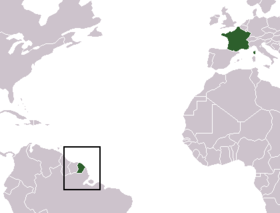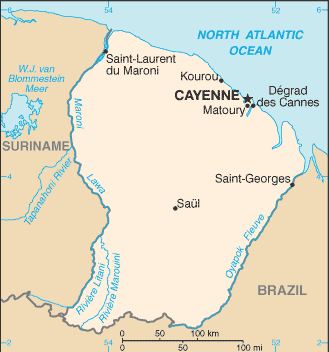French Guiana
2007 Schools Wikipedia Selection. Related subjects: Central & South American Countries; Countries
- Not to be confused with Guyana.
- Not to be confused with French Guinea.
French Guiana (French: Guyane française, officially Guyane) is an overseas département ( département d'outre-mer, or DOM) of France, located on the northern coast of South America. Like the other DOMs, French Guiana is also a région ( région d'outre-mer) of France. As a part of France, French Guiana is in the European Union, and its currency is the euro .
French Guiana is the smallest political entity on the South American mainland (Suriname is the smallest independent South American country). It borders the Atlantic Ocean to the north, Brazil to the east and south, and Suriname to the west. (Part of the border with Suriname is disputed.)
History
First settled by the French in 1604, French Guiana was the site of penal settlements until 1951.
Politics
French Guiana, as part of France, is part of the European Union, the largest part in area outside Europe, with one of the longest E.U. external boundries and a part of the Union outside Europe that is not an island along with the Spanish enclaves in Africa, Ceuta and Melilla. The Head of State is the President of France, who appoints a Préfet (resident at the Prefecture building in Cayenne) as his/her representative. There are two legislative bodies: the 19-member General Council and the 34-member Regional Council, both elected. French Guiana has two seats at the National Assembly in Paris. French Guiana has traditionally been conservative, though the socialist party has been increasingly successful in recent years. Though many would like to see more autonomy for the region, support for complete independence is very low.
A chronic issue affecting French Guiana is the influx of illegal immigrants and clandestine gold prospectors from Brazil and Suriname. The border between the département and Suriname is formed by the Maroni River, which flows through rainforest and is difficult for the French Gendarmerie to patrol. The border line with Suriname is disputed.
Administrative divisions
Administratively, French Guiana is divided into arrondissements, cantons, and communes:
- Arrondissements of Guyane (French Guiana)
- Cantons of Guyane (French Guiana)
- Communes of Guyane (Cities of French Guiana)
Geography
Though sharing cultural affinities with the French-speaking territories of the Caribbean, French Guiana cannot be considered to be part of that region, since the Caribbean Sea actually lies several hundred miles to the west, beyond the arc of the Lesser Antilles.
French Guiana consists of two main geographical regions: a coastal strip where the majority of the people live, and dense, near-inaccessible rainforest which gradually rises to the modest peaks of the Tumac-Humac mountains along the Brazilian frontier. French Guiana's highest peak is Bellevue de l'Inini (851 m / 2,792 ft). Other mountains include Mont Machalou (782 m / 2,566 ft), Pic Coudreau (711 m / 2,333 ft) and Mont St Marcel (635 m / 2,083 ft), Mont Favard (200 m / 656 ft) and Montagne du Mahury (156 m / 512 ft). Several small islands are found off the coast, the three Iles du Salut Salvation Islands which includes Devil's Island and the isolated Ile de Connetable bird sanctury further along the coast towards Brazil.
The Barrage de Petit-Saut hydroelectric dam in the north of French Guiana forms an artificial lake and provides hydroelectricity. There are many rivers in French Guiana.
Economy
French Guiana is heavily dependent on France for subsidies and goods. The main industries are fishing (accounting for three-quarters of foreign exports), gold mining and timber. In addition, the European Space Centre at Kourou accounts for 25% of the GDP and employs about 1700 people. There is very little manufacturing and agriculture is largely undeveloped. Tourism, especially eco-tourism, is growing. Unemployment is a major problem, running at about 20% to 30%.
Demographics
French Guiana's population of 200 000 (2006 est.), most of whom live along the coast, is very ethnically diverse. Estimates of the percentages of French Guiana ethnic composition vary, a problem compounded by the large numbers of legal and illegal immigrants (about 20,000).
Mulattos (People of mixed black and white ancestry) are the largest ethnic group, though estimates vary as to the exact percentage, depending upon whether the large Haitian community is included as well. Generally the Creole population is judged at about 60% to 70% of the total population with Haitians (comprising roughly one-third of Creoles) and 30% to 50% without. Roughly 14% are Europeans, the vast majority of whom are French.
The main Asian communities are the Hmong from Laos (1.5%) and Chinese (3.2%, primarily from Hong Kong and Zhejiang province). There are also smaller groups from various Caribbean islands, mainly Saint Lucia. The main groups living in the interior are the Maroons (also called Bush Negroes) and Amerindians.
The Maroons, descendents of escaped African slaves, live primarily along the Maroni River. The main Maroon groups are the Paramacca, Aucan (both of whom also live in Suriname) and the Boni (Aluku).
The main Amerindian groups (forming about 3%-4% of the population) are the Arawak, Emerillon, Galibi (now called the Kaliña), Palikour, Wayampi (also known as Oyampi) and Wayana.
The predominant religion in the country is Roman Catholicism, though the Maroons and some Amerindian peoples still practice their own religions. The Hmong people are also mainly Catholic owing to the influence of Catholic missionaries who helped bring them to French Guiana.
Notable People
- Florent Malouda, French international football player.
- Henri Charriere, an escaped French convict, imprisoned in and around French Guiana from 1933 to 1945.
- Malia Metella, French swimmer, SC European Championships 2004: 1st 100m free.
- Bernard Lama, former French international football player.
- Cyrille Regis, former West Bromwich Albion and England player.



